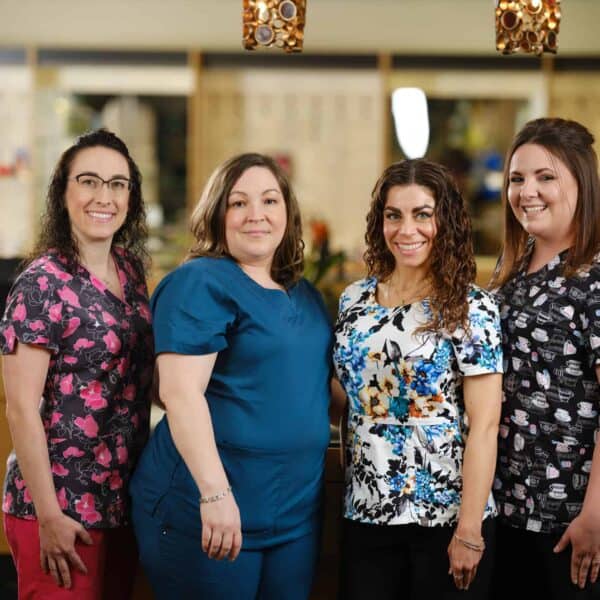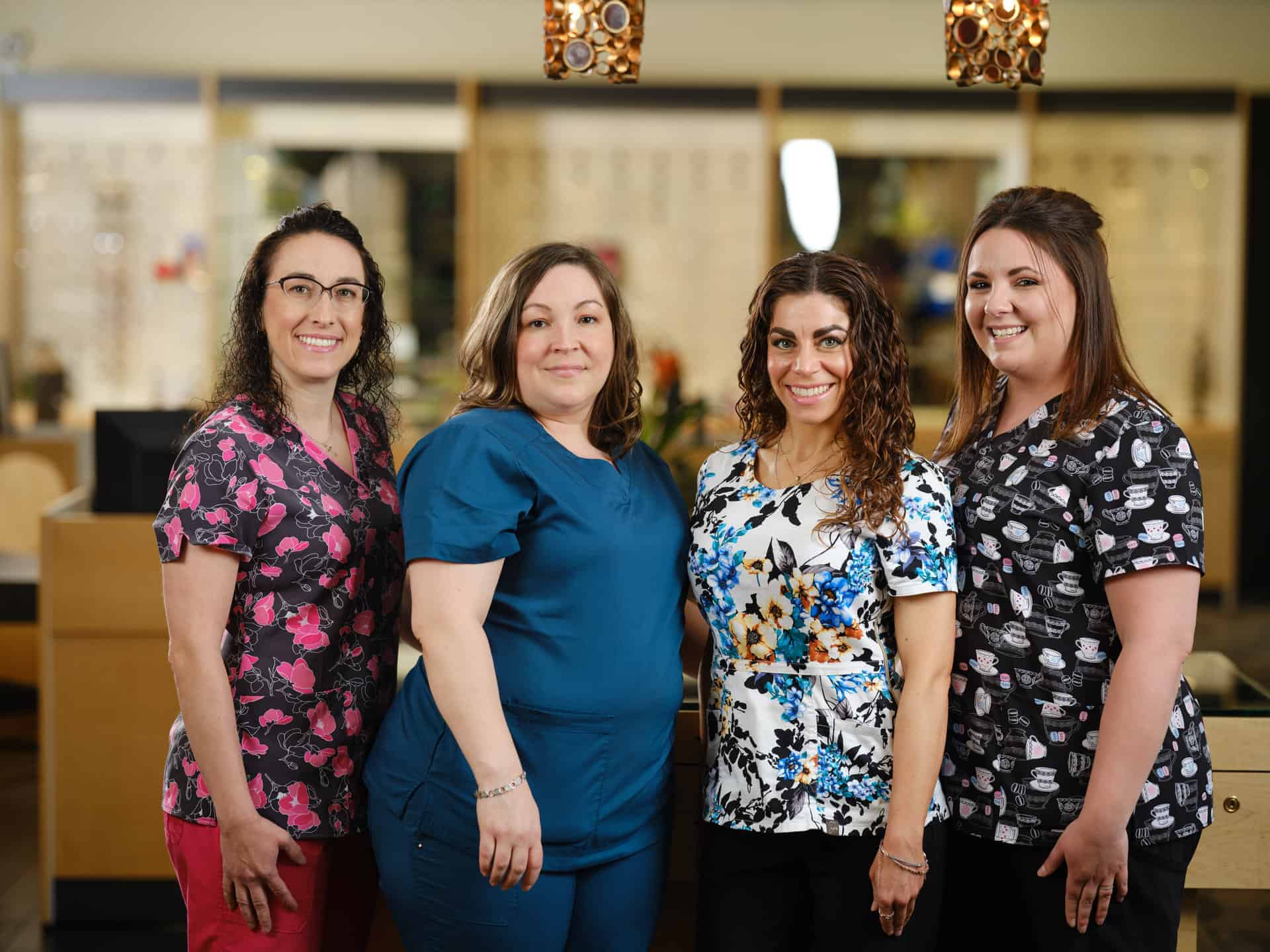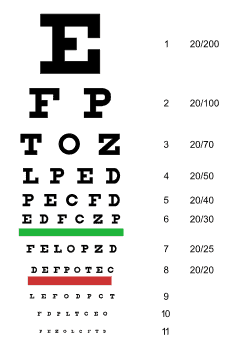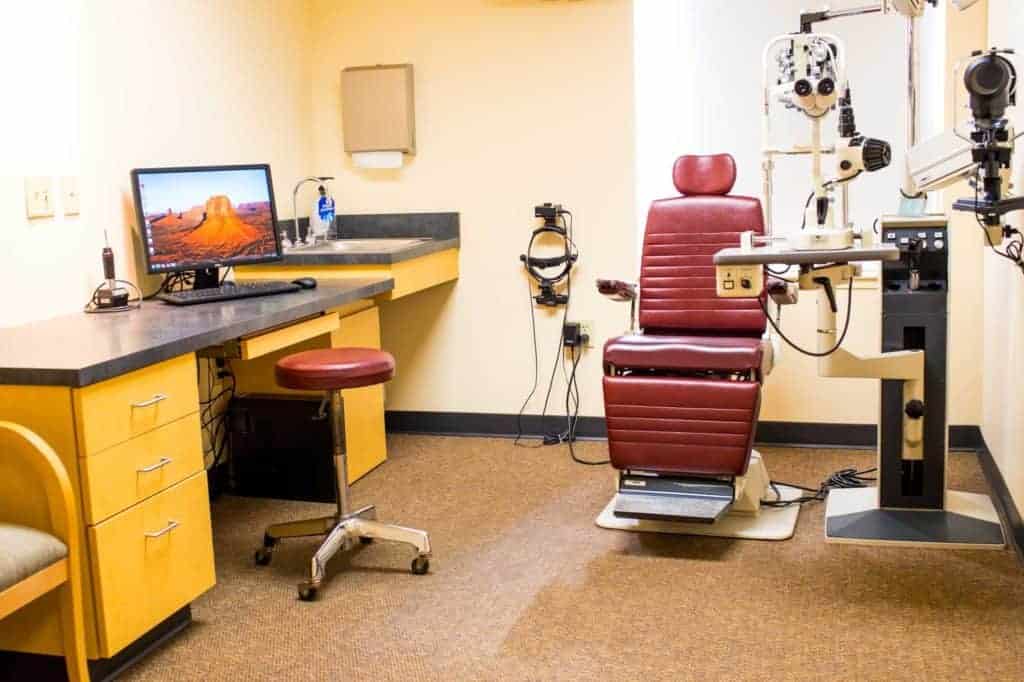
The Role of an Optometric Technician
August 12, 2022

Did you know that your eye exam starts before you even see the doctor? An optometric technician collects valuable information and measurements that direct the flow of the exam once the doctor steps in the room. Technicians also perform visual field testing, contact lens training, and many more tasks. This blog will explain the different tests that the technician completes during a comprehensive eye examination. (Shout out to our four hardworking optometric technicians – Jena, Jennifer, Danielle, and Mandy!)

Pre-Test Room
Before the technician takes you back to an exam room, you’ll make a stop in our “Pre-Test Room.” The first machine with the classic farmhouse or hot air balloon scene is the autorefractor/keratometer. This provides an estimated distance prescription, in addition to measurements of the curvature of the cornea, or the front of the eye. Since there are so many other factors that contribute to finalizing a glasses prescription, the autorefractor just provides a starting point that is refined once you’re answering to “Which is better – 1 or 2?”
The other large piece of equipment in this room is the optical coherence tomography (OCT) machine. OCT is a painless, non-invasive tool that is commonly used to diagnose and monitor changes in those with retinal or optic nerve conditions. The iWellness scans are a bonus feature that we recommend our patients have completed at annual visits. Using OCT technology, the iWellness is a very useful screening tool for early detection of common conditions, such as macular degeneration, diabetic retinopathy, and glaucoma.
Getting the Scoop
Once you’re in the exam room, the technician will ask more about the reason for your visit and any potential concerns you might have. Obtaining the details and reviewing the medical history are important for the doctor to take into consideration when determining a diagnosis. It is also helpful when patients bring a list of their medications to the appointment. Some drug or medication categories can pose a risk to the eyes, even when taken as directed by the prescribing physician. Therefore, please be sure to disclose all medications that are regularly taken.
The Basics
After collecting all of the necessary information, the technician will continue the exam by performing several different types of eye tests. Each test provides insight to the patient’s ocular health.

Extraocular Muscles: The eye muscles around the eyeball are responsible for holding the eyes in proper alignment and moving them in unison. If the eyes cannot smoothly follow the penlight target or move together, there could be a muscle imbalance or nerve problem.
Confrontation Fields: This is a gross test of peripheral vision. Glaucoma, brain tumors, and strokes can result in loss of peripheral vision. If there is a concern with peripheral vision, a full visual field test can be completed for more detailed information regarding the location and severity of the loss.
Eye Pressure: Measuring the intraocular pressure, or pressure inside the eye, is part of the glaucoma screening. Individuals with high eye pressure are at a greater risk for glaucoma, which is a chronic, progressive condition that causes damage to the optic nerve. There are no symptoms associated with mildly elevated eye pressure, so early detection of glaucoma is important for initiating treatment as soon as possible.
Color Vision: Although color vision is typically not assessed every year, it provides more information than whether an individual can properly match a clothing outfit. Certain optic nerve conditions, including optic neuropathy from multiple sclerosis and glaucoma, can change the way a person perceives color. More commonly occurring in males, red-green color deficiency is a harmless, inherited condition that affects many people.
Depth Perception: This test is usually performed on new patients under 40 years of age because changes to near vision, in those older than 40 years, can impact the results of the test. In order to have binocular (both eyes working together) depth perception, the eyes need to be aligned properly. People with strabismus, or an eye turn, do not have traditional depth perception when an eye is drifting outwards or crossed inwards.

Remember – your eye exam starts from the moment the technician leads you to the pre-test room. The technicians gather all the data and measurements that are necessary for the doctor to begin her part of your eye exam. We hope you learned something new about your experience here at Weber Vision Care!